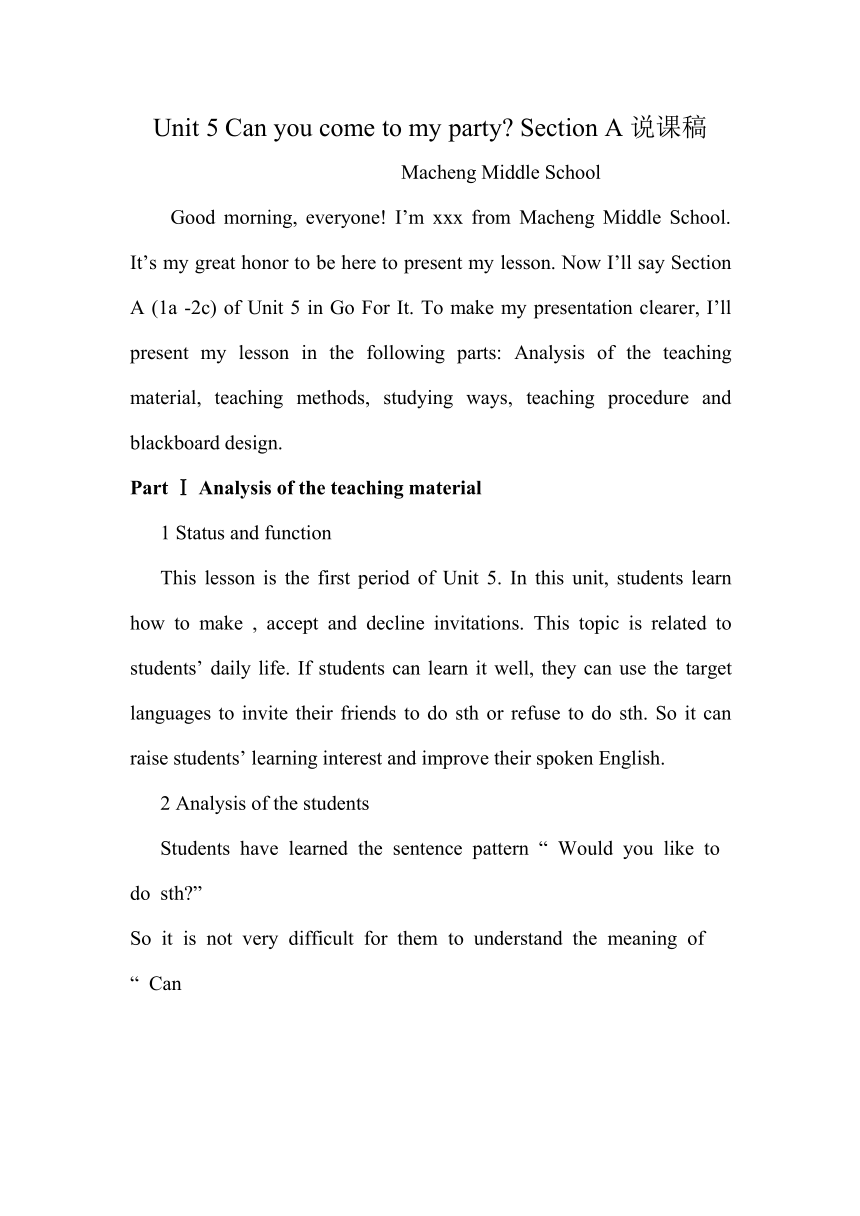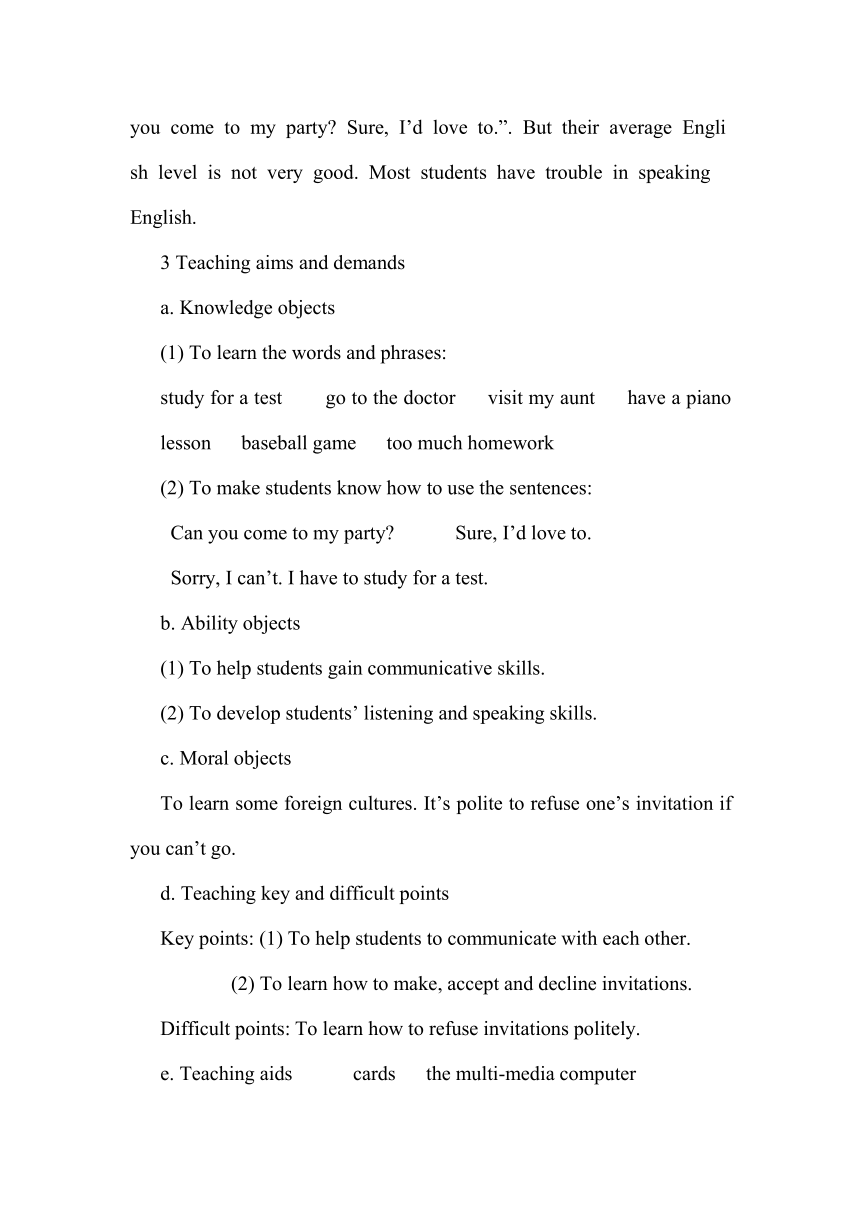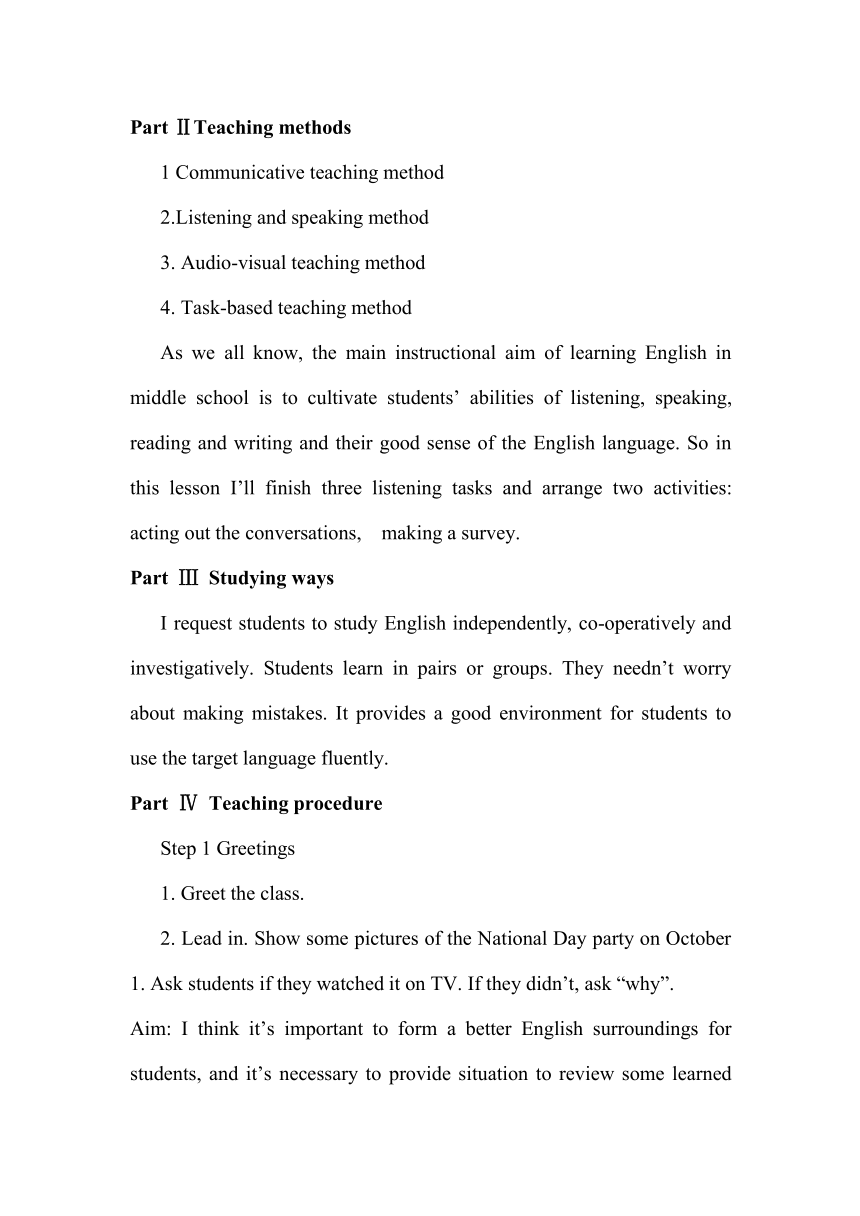Unit 5 Can you come to my party? Section A说课稿
文档属性
| 名称 | Unit 5 Can you come to my party? Section A说课稿 |

|
|
| 格式 | zip | ||
| 文件大小 | 14.7KB | ||
| 资源类型 | 教案 | ||
| 版本资源 | 人教新目标(Go for it)版 | ||
| 科目 | 英语 | ||
| 更新时间 | 2012-03-03 23:30:32 | ||
图片预览



文档简介
Unit 5 Can you come to my party Section A说课稿
Macheng Middle School
Good morning, everyone! I’m xxx from Macheng Middle School. It’s my great honor to be here to present my lesson. Now I’ll say Section A (1a -2c) of Unit 5 in Go For It. To make my presentation clearer, I’ll present my lesson in the following parts: Analysis of the teaching material, teaching methods, studying ways, teaching procedure and blackboard design.
Part Ⅰ Analysis of the teaching material
1 Status and function
This lesson is the first period of Unit 5. In this unit, students learn how to make , accept and decline invitations. This topic is related to students’ daily life. If students can learn it well, they can use the target languages to invite their friends to do sth or refuse to do sth. So it can raise students’ learning interest and improve their spoken English.
2 Analysis of the students
Students have learned the sentence pattern “ Would you like to do sth ”
So it is not very difficult for them to understand the meaning of “ Can
you come to my party Sure, I’d love to.”. But their average English level is not very good. Most students have trouble in speaking English.
3 Teaching aims and demands
a. Knowledge objects
(1) To learn the words and phrases:
study for a test go to the doctor visit my aunt have a piano lesson baseball game too much homework
(2) To make students know how to use the sentences:
Can you come to my party Sure, I’d love to.
Sorry, I can’t. I have to study for a test.
b. Ability objects
(1) To help students gain communicative skills.
(2) To develop students’ listening and speaking skills.
c. Moral objects
To learn some foreign cultures. It’s polite to refuse one’s invitation if you can’t go.
d. Teaching key and difficult points
Key points: (1) To help students to communicate with each other.
(2) To learn how to make, accept and decline invitations.
Difficult points: To learn how to refuse invitations politely.
e. Teaching aids cards the multi-media computer
Part ⅡTeaching methods
1 Communicative teaching method
2.Listening and speaking method
3. Audio-visual teaching method
4. Task-based teaching method
As we all know, the main instructional aim of learning English in middle school is to cultivate students’ abilities of listening, speaking, reading and writing and their good sense of the English language. So in this lesson I’ll finish three listening tasks and arrange two activities: acting out the conversations, making a survey.
Part Ⅲ Studying ways
I request students to study English independently, co-operatively and investigatively. Students learn in pairs or groups. They needn’t worry about making mistakes. It provides a good environment for students to use the target language fluently.
Part Ⅳ Teaching procedure
Step 1 Greetings
1. Greet the class.
2. Lead in. Show some pictures of the National Day party on October 1. Ask students if they watched it on TV. If they didn’t, ask “why”.
Aim: I think it’s important to form a better English surroundings for students, and it’s necessary to provide situation to review some learned phrases.
Step 2 Presentation
1. Show some pictures on the screen and ask students “What are they doing ” to present the following phrases:
go to the doctor, study for a test , have a piano lesson,
help his/her parents, visit his/her aunt
2. Ask students to fill in the blanks in 1a individually. Then check the answers.
Aim: I present the phrases by CAL in order to make it easier for students to learn and grasp the meanings. It’ll raise students’ learning interest.
Step 3 Listening
1. Present the picture on the screen and tell students Sun Ning is going to have a party on Saturday afternoon. Ask students to listen to the tape and find out who is/isn’t going to the party and why.
2. Listen to the tape again and complete 1b. Check the answers.
Aim: It’s a little hard for students to finish 1b by listening to the tape just once. So I divide it into two periods. It will make students feel more confident.
Step 4 Group work
1. Ask students to read the conversation. Then ask students to practice in groups like this:
A: Hey, Ted. Can you come to my party
B: I’m sorry, I can’t.
A: Can you come to my party
C: …
2. Ask some groups to act out their conversations in front of the class and find out which group does best.
Aim: I think this step can help students understand the conversation better. At the same time, students can improve their listening and speaking skills.
Step 5 Listening
1. Ask students to read the sentences in 2a.
2. Listen to the tape and complete 2a. Check the answers.
3. Listen again and find out the reasons why people can’t go to the party.
Check the answers.
Aim: I design this step to improve students’ listening skills.
Step 6 Making a survey
1. Give each student a form and ask them to complete the form by asking their classmates if they can/can’t do sth and why.
Question Name Answer Reason
Can you come to my party
Can you go shopping with me
Can you come to my home to have dinner
Can you play soccer with us
Can you have art class with me this Sunday
2. Ask some students to give a report in front of the class. Give them claps if they do it well.
Aim: I design this step to encourage students to talk with their classmates. They needn’t worry about making mistakes. They can help each other and learn from each other.
Step 7 Homework
Write a short passage according to the survey.
Step 8 Summary
In this lesson, students learn how to make , accept and decline invitations. They can use the sentences to communicate with their friends in their daily life. And they improve their speaking, reading and listening skills in the class.
Part Ⅴ Blackboard design
Can you come to my party study for a test Can you come to my party go to the doctor Sure, I’d love to.have a piano lesson Sorry, I can’t. I have to …help my parentsvisit my aunt
Teaching reflection:
In this lesson, I mainly adopt listening and speaking teaching method and task-based learning method. I try to have students learn by reading, listening and practicing. I also arrange individual work, pair work and group work for students to practice English. I think students can improve their listening skills and spoken English in class.
Thanks for listening!
Macheng Middle School
Good morning, everyone! I’m xxx from Macheng Middle School. It’s my great honor to be here to present my lesson. Now I’ll say Section A (1a -2c) of Unit 5 in Go For It. To make my presentation clearer, I’ll present my lesson in the following parts: Analysis of the teaching material, teaching methods, studying ways, teaching procedure and blackboard design.
Part Ⅰ Analysis of the teaching material
1 Status and function
This lesson is the first period of Unit 5. In this unit, students learn how to make , accept and decline invitations. This topic is related to students’ daily life. If students can learn it well, they can use the target languages to invite their friends to do sth or refuse to do sth. So it can raise students’ learning interest and improve their spoken English.
2 Analysis of the students
Students have learned the sentence pattern “ Would you like to do sth ”
So it is not very difficult for them to understand the meaning of “ Can
you come to my party Sure, I’d love to.”. But their average English level is not very good. Most students have trouble in speaking English.
3 Teaching aims and demands
a. Knowledge objects
(1) To learn the words and phrases:
study for a test go to the doctor visit my aunt have a piano lesson baseball game too much homework
(2) To make students know how to use the sentences:
Can you come to my party Sure, I’d love to.
Sorry, I can’t. I have to study for a test.
b. Ability objects
(1) To help students gain communicative skills.
(2) To develop students’ listening and speaking skills.
c. Moral objects
To learn some foreign cultures. It’s polite to refuse one’s invitation if you can’t go.
d. Teaching key and difficult points
Key points: (1) To help students to communicate with each other.
(2) To learn how to make, accept and decline invitations.
Difficult points: To learn how to refuse invitations politely.
e. Teaching aids cards the multi-media computer
Part ⅡTeaching methods
1 Communicative teaching method
2.Listening and speaking method
3. Audio-visual teaching method
4. Task-based teaching method
As we all know, the main instructional aim of learning English in middle school is to cultivate students’ abilities of listening, speaking, reading and writing and their good sense of the English language. So in this lesson I’ll finish three listening tasks and arrange two activities: acting out the conversations, making a survey.
Part Ⅲ Studying ways
I request students to study English independently, co-operatively and investigatively. Students learn in pairs or groups. They needn’t worry about making mistakes. It provides a good environment for students to use the target language fluently.
Part Ⅳ Teaching procedure
Step 1 Greetings
1. Greet the class.
2. Lead in. Show some pictures of the National Day party on October 1. Ask students if they watched it on TV. If they didn’t, ask “why”.
Aim: I think it’s important to form a better English surroundings for students, and it’s necessary to provide situation to review some learned phrases.
Step 2 Presentation
1. Show some pictures on the screen and ask students “What are they doing ” to present the following phrases:
go to the doctor, study for a test , have a piano lesson,
help his/her parents, visit his/her aunt
2. Ask students to fill in the blanks in 1a individually. Then check the answers.
Aim: I present the phrases by CAL in order to make it easier for students to learn and grasp the meanings. It’ll raise students’ learning interest.
Step 3 Listening
1. Present the picture on the screen and tell students Sun Ning is going to have a party on Saturday afternoon. Ask students to listen to the tape and find out who is/isn’t going to the party and why.
2. Listen to the tape again and complete 1b. Check the answers.
Aim: It’s a little hard for students to finish 1b by listening to the tape just once. So I divide it into two periods. It will make students feel more confident.
Step 4 Group work
1. Ask students to read the conversation. Then ask students to practice in groups like this:
A: Hey, Ted. Can you come to my party
B: I’m sorry, I can’t.
A: Can you come to my party
C: …
2. Ask some groups to act out their conversations in front of the class and find out which group does best.
Aim: I think this step can help students understand the conversation better. At the same time, students can improve their listening and speaking skills.
Step 5 Listening
1. Ask students to read the sentences in 2a.
2. Listen to the tape and complete 2a. Check the answers.
3. Listen again and find out the reasons why people can’t go to the party.
Check the answers.
Aim: I design this step to improve students’ listening skills.
Step 6 Making a survey
1. Give each student a form and ask them to complete the form by asking their classmates if they can/can’t do sth and why.
Question Name Answer Reason
Can you come to my party
Can you go shopping with me
Can you come to my home to have dinner
Can you play soccer with us
Can you have art class with me this Sunday
2. Ask some students to give a report in front of the class. Give them claps if they do it well.
Aim: I design this step to encourage students to talk with their classmates. They needn’t worry about making mistakes. They can help each other and learn from each other.
Step 7 Homework
Write a short passage according to the survey.
Step 8 Summary
In this lesson, students learn how to make , accept and decline invitations. They can use the sentences to communicate with their friends in their daily life. And they improve their speaking, reading and listening skills in the class.
Part Ⅴ Blackboard design
Can you come to my party study for a test Can you come to my party go to the doctor Sure, I’d love to.have a piano lesson Sorry, I can’t. I have to …help my parentsvisit my aunt
Teaching reflection:
In this lesson, I mainly adopt listening and speaking teaching method and task-based learning method. I try to have students learn by reading, listening and practicing. I also arrange individual work, pair work and group work for students to practice English. I think students can improve their listening skills and spoken English in class.
Thanks for listening!
同课章节目录
- Unit 1 Where did you go on vacation?
- Section A
- Section B
- Unit 2 How often do you exercise?
- Section A
- Section B
- Unit 3 I'm more outgoing than my sister.
- Section A
- Section B
- Unit 4 What's the best movie theater?
- Section A
- Section B
- Unit 5 Do you want to watch a game show?
- Section A
- Section B
- Unit 6 I'm going to study computer science.
- Section A
- Section B
- Unit 7 Will people have robots?
- Section A
- Section B
- Unit 8 How do you make a banana milk shake?
- Section A
- Section B
- Unit 9 Can you come to my party?
- Section A
- Section B
- Unit 10 If you go to the party, you'll have a grea
- Section A
- Section B
